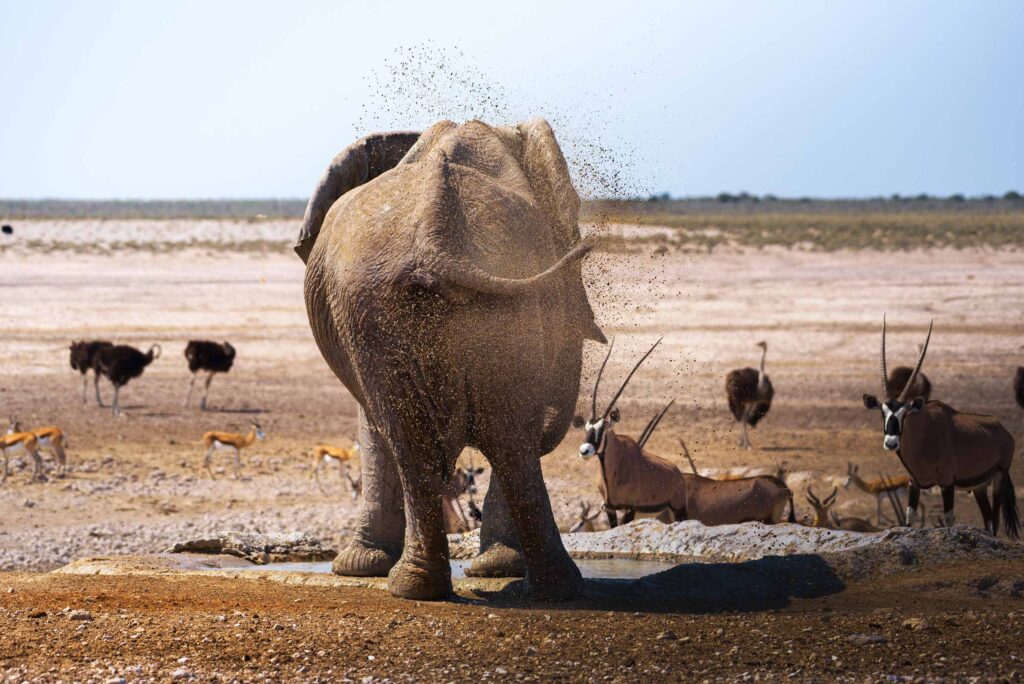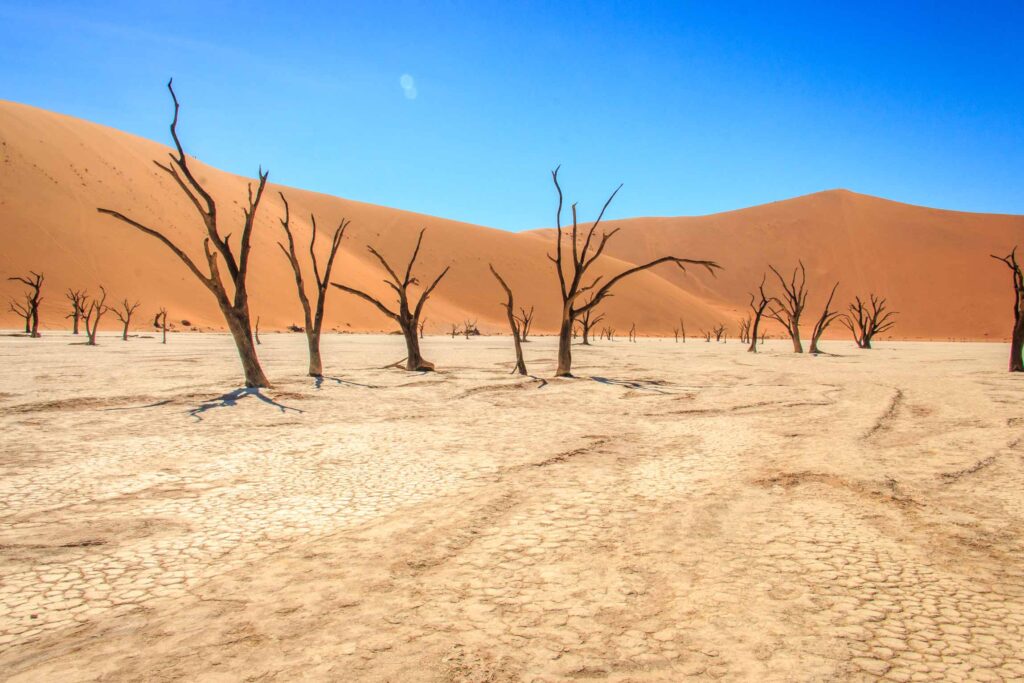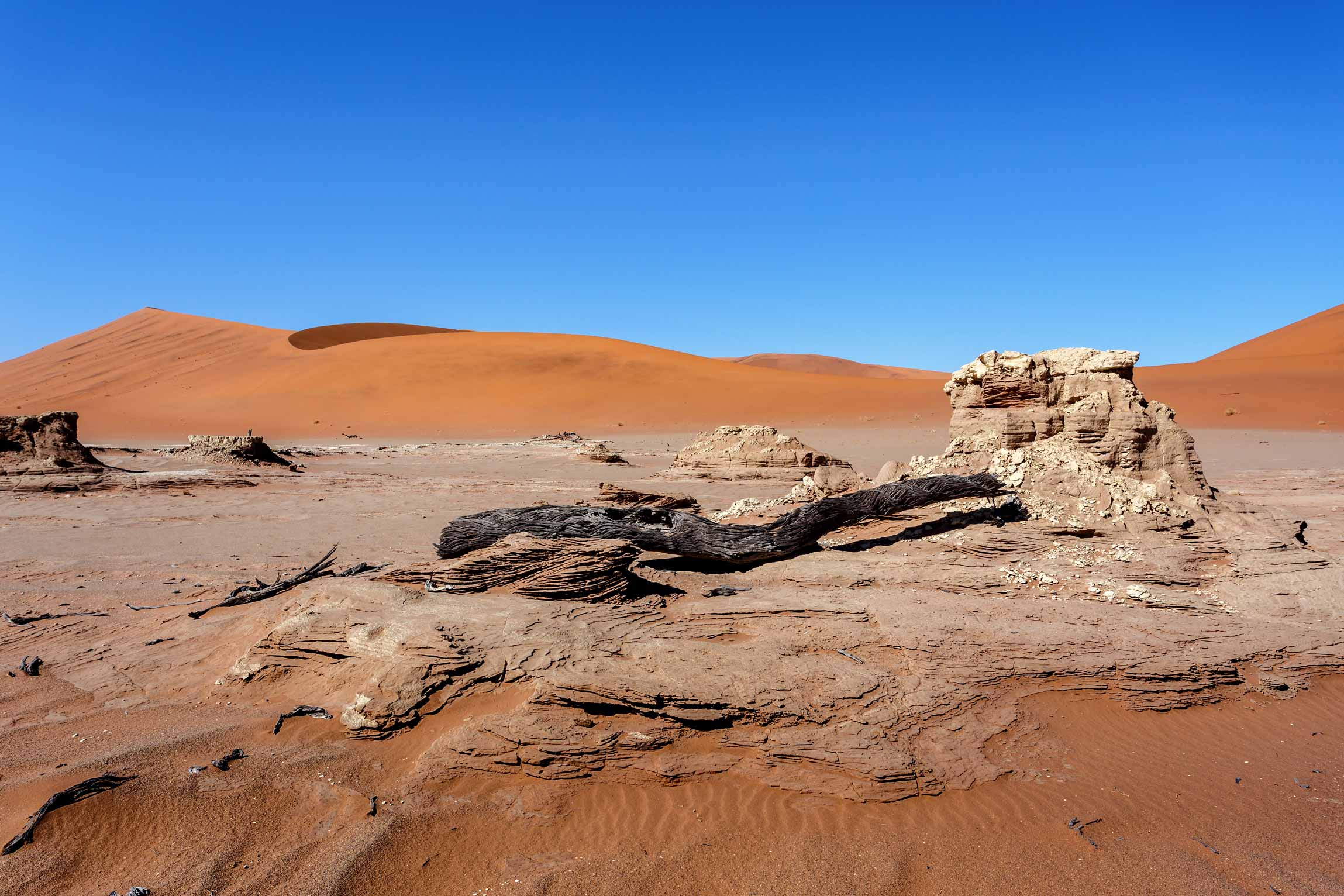Namibia’s landscape is one of dramatic contrasts—where the ancient dunes of the Namib Desert stretch all the way to the cold Atlantic, and rugged mountains rise from endless plains. Whether you’re venturing deep into the wilderness of Damaraland or admiring the wildlife-rich savannahs of Etosha, Namibia travel promises experiences that thrill, inspire, and offer unparalleled tranquility. With this Namibia travel advice, you’ll be fully prepared to explore a country that offers both adventure and serenity, making it an unforgettable destination for any traveler.
In Southern Africa, bordered by Angola, Zambia, Botswana, and South Africa, Namibia is famous for its open spaces and lack of crowds. As the second least densely populated country in the world, it offers solitude and exploration like few other destinations. Whether hiking through canyons, photographing wildlife in Etosha, or navigating desert tracks, Namibia is a playground for those seeking unspoiled beauty.
Namibia is home to 13 distinct ethnic groups, each contributing to the country’s rich cultural mosaic. The Ovambo people form the largest group, but the Himba, Damara, and Herero communities are just as important in shaping Namibia’s identity. While English is spoken widely, you’ll also hear Afrikaans, German, and indigenous languages like Nama and Herero, reflecting the country’s unique history and diversity. Visitors leave Namibia not just with images of its landscapes, but with the deeper understanding that comes from meaningful cultural encounters.
Geography and Climate
Namibia is a land of extremes. The country is dominated by desert landscapes—most notably the Namib Desert, one of the world’s oldest deserts, which stretches along the entire Atlantic coastline. Inland, you’ll find the Kalahari Desert, mountain ranges, and vast plateaus. Despite its arid environment, Namibia is home to rich ecosystems and an abundance of wildlife, including elephants, lions, and the elusive black rhino.
The climate in Namibia is typically hot and dry. Summers (November to April) can get very warm, especially in the desert regions, with daytime temperatures often soaring above 35°C (95°F). Winter months (May to October) are cooler, with crisp mornings and warm days, making it an ideal time for outdoor activities and wildlife viewing.
When to Visit: The Best Time for Your Namibian Adventure

While Namibia is a year-round destination, the best time to visit largely depends on what you want to experience. For wildlife lovers, the dry season from May to September is ideal, as animals are easier to spot around the shrinking water sources in Etosha National Park. The temperatures are cooler during this time, making it more comfortable for long days of exploring.
If you’re eager to see the iconic red dunes of Sossusvlei or experience the eerie Skeleton Coast, you might prefer the months between April and June or September to November, when the weather is milder, and the landscapes are at their most dramatic.
For those seeking a truly unique experience, the summer months (November to March) bring the rare sight of desert in bloom after the rains, transforming Namibia into a green oasis
Getting Around Namibia: Navigating the Desert Roads
Namibia’s rugged beauty is best explored by road, and many travelers opt for a self-drive adventure. The country has an excellent network of gravel roads, and driving offers the freedom to explore at your own pace. However, be mindful that the roads can be rough, and distances between towns are vast, so a sturdy 4×4 vehicle is often recommended, especially if you plan on venturing off the beaten path into areas like Damaraland or Kaokoland.
Alternatively, if you’re short on time or not keen on driving yourself, guided tours are an excellent option. Many operators offer customized tours that cater to specific interests, whether it’s wildlife photography, cultural immersion, or adrenaline-pumping activities like sandboarding and skydiving.
Important Travel Tips
- Fuel up frequently: Petrol stations are few and far between, so top up your tank whenever you can.
- Take it slow: Namibia’s gravel roads can be tricky, so drive cautiously, especially after rain when conditions can worsen.
- GPS is your friend: With vast landscapes and minimal signage, having a GPS or offline maps is essential to stay on course.
What to Pack for Your Namibian Adventure
Packing for Namibia requires thoughtful consideration of the country’s climate and the nature of your activities. Here’s a list of essentials to ensure you’re well-prepared:
- Lightweight, breathable clothing: Namibia can get extremely hot, especially in the desert. Opt for loose-fitting clothes made from natural fabrics like cotton or linen.
- Warm layers: While the days can be scorching, evenings in the desert and early mornings on safari can be chilly, especially during the winter months.
- Sturdy hiking shoes: If you plan on exploring the dunes or hiking through canyons, good quality, supportive footwear is essential.
- Sun protection: Namibia’s sun is intense. A wide-brimmed hat, sunglasses, and high-SPF sunscreen are a must.
- Reusable water bottle: Staying hydrated is crucial in this arid environment, and many lodges provide refilling stations to reduce plastic waste.
- Binoculars and camera gear: Namibia offers some of the best wildlife viewing in Africa, so pack binoculars and plenty of memory cards to capture the magic.
Top Experiences in Namibia: Must-Do Adventures

Namibia is full of incredible experiences that will leave you breathless and yearning for more. Here are some must-do adventures to add to your itinerary:
Climb Dune 45 in Sossusvlei
The towering sand dunes of Sossusvlei are one of Namibia’s most iconic sights. Dune 45, in particular, is famous for its breathtaking views, especially at sunrise. The climb is challenging but rewarding, with panoramic vistas of the red desert below.
Explore Etosha National Park
Etosha is Namibia’s premier safari destination, offering a wildlife experience like no other. The park is home to an incredible array of animals, from majestic lions to towering elephants and graceful zebras. Whether you drive yourself or join a guided tour, every turn reveals new wonders. Keep your camera ready, as you might spot elusive species like the black rhino or even cheetahs in the open plains. The salt pan, stretching endlessly across the heart of the park, creates a dramatic, shimmering landscape that feels almost otherworldly, especially at sunset when the light paints the sky in vivid colors.
Visit the Skeleton Coast
Named for the countless shipwrecks that litter its shores, the Skeleton Coast is one of the most hauntingly beautiful places on earth. Stretching along Namibia’s northwestern coast, this desolate yet mesmerizing region feels like stepping into another world. Explore eerie coastal plains shrouded in fog, where the icy Atlantic meets the desert, and discover colonies of Cape fur seals basking on rocky shores. As you wander along misty beaches, you’ll come across rusting remnants of ships—silent reminders of nature’s unforgiving power and the perilous history of this wild, untamed coastline.
Meet the Himba People in Kaokoland
For a cultural experience, head north to Kaokoland to meet the semi-nomadic Himba people. Famous for their ochre-painted skin and intricate hairstyles, the Himba are one of Namibia’s most recognizable tribes. Visiting a Himba village offers a glimpse into their traditional way of life.
Discover Fish River Canyon
The Fish River Canyon, located in the southern part of Namibia, is the second-largest canyon in the world and one of the country’s most awe-inspiring natural wonders. Stretching over 160 kilometers long, up to 27 kilometers wide, and plunging to depths of 550 meters, the canyon offers jaw-dropping vistas at every turn. Its rugged terrain makes it a haven for adventure seekers, with hiking trails that challenge even the most experienced trekkers. The multi-day Fish River Canyon hike, which spans about 85 kilometers, is one of Africa’s most epic treks, taking you through dramatic landscapes, past sheer cliffs, and along the meandering Fish River. The best time to hike the canyon is during the cooler months from May to September, ensuring a more comfortable experience in this remote wilderness. Whether you’re there to hike or simply admire the views, Fish River Canyon promises an unforgettable adventure.
Top Tips for Travelling Namibia
- Stock up on supplies: When heading into remote areas, ensure you have plenty of water, snacks, and a first-aid kit.
- Cash is king: ATMs are scarce outside major towns, so carry enough cash for fuel, tips, and small purchases.
- Respect the wildlife: Namibia is home to some of Africa’s most incredible creatures. Always keep a safe distance, and never leave your vehicle in game parks.
- Stay hydrated: Namibia’s dry heat can be deceptively draining, so drink plenty of water, even if you don’t feel thirsty.
Explore Namibia’s Wonders with Visit Africa
At Visit Africa, we don’t just plan trips; we craft journeys that immerse you in Namibia’s breathtaking landscapes and cultural treasures. From the surreal sandscapes of the Namib Desert to the wildlife-packed savannahs of Etosha, our custom itineraries are designed to let you experience Namibia like never before. Imagine hiking through Fish River Canyon or meeting the Himba people in their traditional villages—every moment is tailored to your personal sense of adventure.
Ready to explore Namibia’s wild heart? Let Visit Africa be your guide to this extraordinary land.














